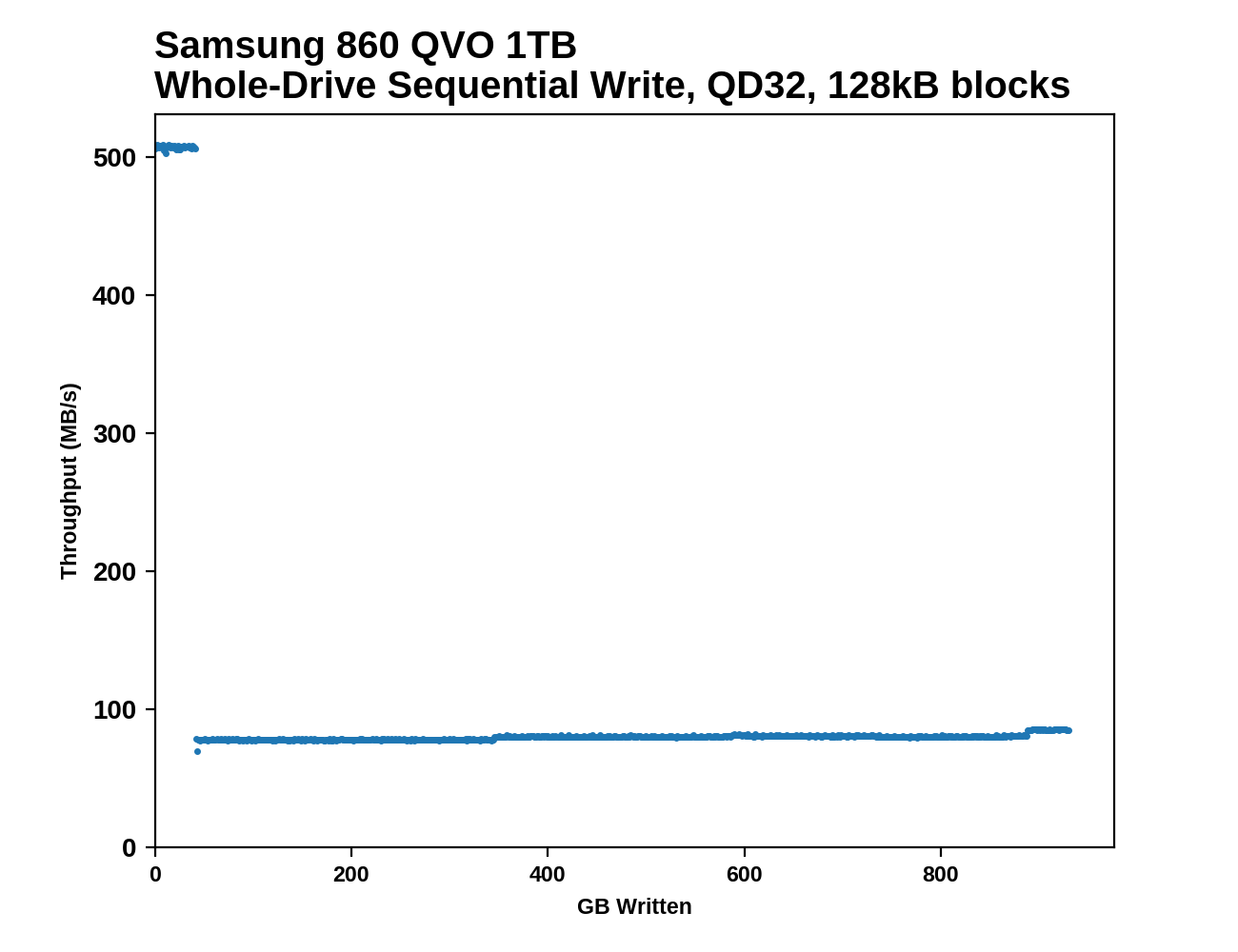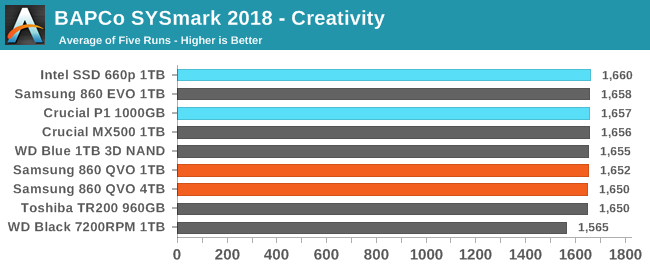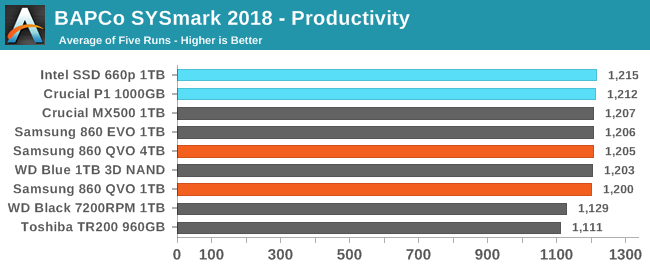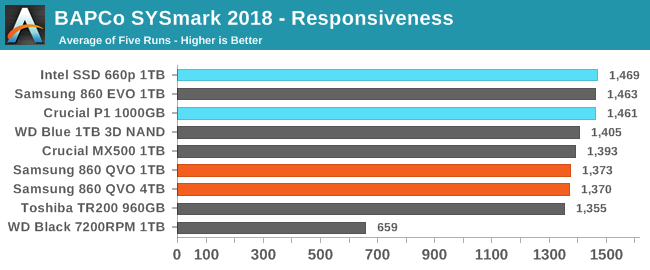The Samsung 860 QVO (1TB, 4TB) SSD Review: First Consumer SATA QLC
by Billy Tallis on November 27, 2018 11:20 AM ESTWhole-Drive Fill: Testing SLC Cache Size
This test starts with a freshly-erased drive and fills it with 128kB sequential writes at queue depth 32, recording the write speed for each 1GB segment. This test is not representative of any ordinary client/consumer usage pattern, but it does allow us to observe transitions in the drive's behavior as it fills up. This can allow us to estimate the size of any SLC write cache, and get a sense for how much performance remains on the rare occasions where real-world usage keeps writing data after filling the cache. Samsung's official specifications are:
| Samsung 860 QVO Secondary Specifications | |||||
| Capacity | 1 TB | 2 TB | 4 TB | ||
| SLC Cache Size |
Min | 6 GB | 6 GB | 6 GB | |
| Max | 42 GB | 78 GB | 78 GB | ||
| Sequential Write |
SLC Cache | 520 MB/s | |||
| QLC | 80 MB/s | 160 MB/s | 160 MB/s | ||
Our results show the following:
 |
|||||||||
The Samsung 860 QVOs run out of SLC cache right on schedule, at 42 GB for the 1TB model and 78 GB for the 4TB. After that, they are both slow and very steady for the rest of the test.
 |
|||||||||
| Average Throughput for last 16 GB | Overall Average Throughput | ||||||||
The 1TB 860 QVO falls below the sequential write speed of a 1TB hard drive once the SLC cache runs out, but the 4TB model is able to sustain twice the write speed and remains ahead of not just the hard drive's speed, but also some of the slower TLC drives.
BAPCo SYSmark 2018
BAPCo's SYSmark 2018 is an application-based benchmark that uses real-world applications to replay usage patterns of business users, with subscores for productivity, creativity and responsiveness. Scores represnt overall system performance and are calibrated against a reference system that is defined to score 1000 in each of the scenarios. A score of, say, 2000, would imply that the system under test is twice as fast as the reference system.
SYSmark scores are based on total application response time as seen by the user, including not only storage latency but time spent by the processor. This means there's a limit to how much a storage improvement could possibly increase scores, because the SSD is only in use for a small fraction of the total test duration. This is a significant difference from our ATSB tests where only the storage portion of the workload is replicated and disk idle times are cut short to a maximum of 25ms.
| AnandTech SYSmark SSD Testbed | |
| CPU | Intel Core i5-7400 |
| Motherboard | ASUS PRIME Z270-A |
| Chipset | Intel Z270 |
| Memory | 2x 8GB Corsair Vengeance DDR4-2400 CL17 |
| Case | In Win C583 |
| Power Supply | Cooler Master G550M |
| OS | Windows 10 64-bit, version 1803 |
Our SSD testing with SYSmark uses a different test system than the rest of our SSD tests. This machine is set up to measure total system power consumption rather than just the drive's power.



The 860 QVO isn't any slower for compute-heavy interactive tasks than the mainstream SATA SSDs, and even on the more I/O-bound Responsiveness test the 860 QVO is ahead of the DRAMless TLC drive and not far behind the Crucial MX500.
Energy Use
The SYSmark energy usage scores measure total system power consumption, excluding the display. Our SYSmark test system idles at around 26 W and peaks at over 60 W measured at the wall during the benchmark run. SATA SSDs seldom exceed 5 W and idle at a fraction of a watt, and the SSDs spend most of the test idle. This means the energy usage scores will inevitably be very close. A typical notebook system will tend to be better optimized for power efficiency than this desktop system, so the SSD would account for a much larger portion of the total and the score difference between SSDs would be more noticeable.

The Samsung 860 QVO's energy usage during SYSmark is not a problem at all, with it using slightly less energy than the mainstream SATA TLC drives.










109 Comments
View All Comments
Lolimaster - Thursday, November 29, 2018 - link
SSHD's shoudl use optane, like 32GB.Lolimaster - Thursday, November 29, 2018 - link
And let you manually mirror files that you want accelerated.h0007h - Wednesday, November 28, 2018 - link
It's even slower than HDD。 Why not buy a regular HDD with an Optane? That's much cheaper.piroroadkill - Wednesday, November 28, 2018 - link
It seems to me like the move from TLC to QLC is not just a bit worse, but monumentally so. QLC would have to be a LOT cheaper than TLC to warrant a purchase, not just a bit.piroroadkill - Wednesday, November 28, 2018 - link
"The current street prices for the 860 EVO are lower than the 860 QVO for two out of three capacities, and that's comparing against one of the best SATA SSDs out there."Which makes QLC as a worthless product. I don't think 25% off the cheapest TLC SSDs would be enough, because it seems even worse than that.
rpg1966 - Wednesday, November 28, 2018 - link
Right, because these at-introduction prices will never fall, just like with every other product in the history of the universe.Kamgusta - Wednesday, November 28, 2018 - link
CONCLUSIONS: Current QLC drives are trash.vortmax2 - Wednesday, November 28, 2018 - link
In the end, it's good to see this quad tech coming to the consumers. We're now within striking distance for true HDD to SSD storage/mirror conversion. In the next year or two, pricing will lower enough for many to make the leap.nwarawa - Wednesday, November 28, 2018 - link
YES! Finally! Samsung GETS it! 512GB QLC models should not exist. Even 512GB models with current 3D TLC don't reach the parallelism performance sweet spot. The 2TB model, when priced right, should all but eliminate the case for consumer 2.5in HDDs.Kaihekoa - Wednesday, November 28, 2018 - link
Pretty underwhelming performance and too expensive. I'd buy at 10 centers/GB.